Global Configuration
Tempo Budgets's Global Configuration allows you to specify configuration settings that will provide the default configuration for new Folios you create. To access Tempo Budgets's Global Configuration, go to the Manage Portfolios page and click the Global Settings at the top right of the page. You can also reach the Global Configuration through the add-on's configuration: go to Administration > Add-ons and then click Tempo Budgets > Global Settings in the navigation bar on the left.
You must be a Budgets Super Administrator to modify the Global Configuration. Cost Rates Managers also have access to Global Settings but can only modify Global Cost Rates.

Note
Global Configuration settings that can be overridden at the Folio level are used as default values at Folio creation time. Thus their modification won't affect existing Folios.
Accounting
Default Accounting configuration for new Folios. These settings will be selected by default in the "Create New Folio" dialog but can be overridden if need be.
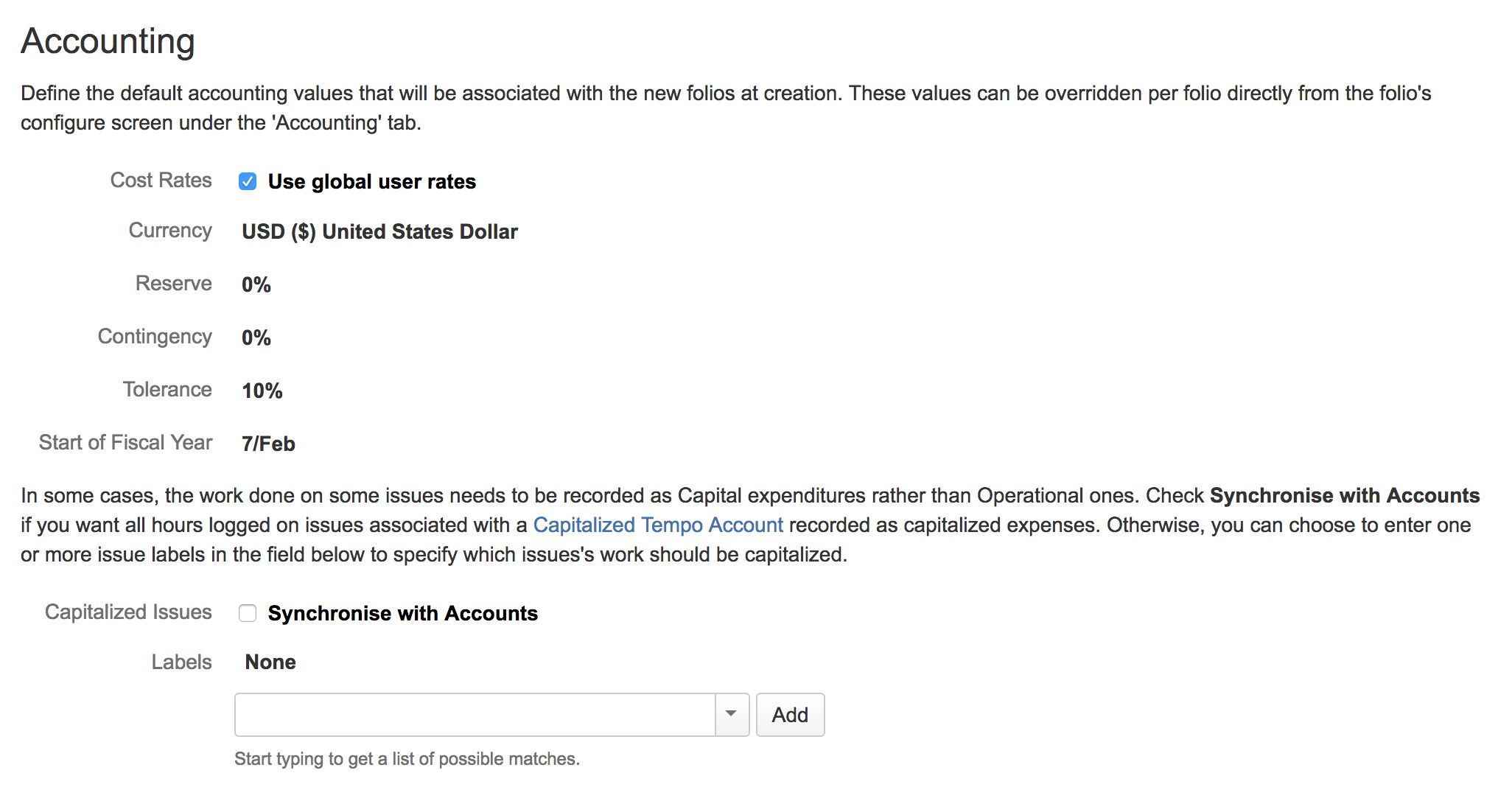
|
Cost Rates |
Determines whether to use centralized User cost rates to calculate actual costs incurred by the Folio's staff members or to use Cost Rates local to the Folio, that will be specified by a Project manager administering the Folio. Select the Use global user rates option to use the centralized rates. |
|---|---|
|
Currency |
Currency to be used for all amounts of the Folio. |
|
Reserve |
Management reserve is for unforeseen risks. It is a percentage of the total budget. |
|
Contingency |
Contingency is for known risks. It is a percentage of every expense's payment. |
|
Tolerance |
Tolerance percentage for the folio's performance indices. |
|
Start of Fiscal Year |
The start date of the Fiscal Year for this Folio. If you select a different starting date for the Fiscal Year, you can report based on this period by selecting "Fiscal Year" under the "Display results of" field in some of the available reports. |
|
Capitalized Issues |
Labels or Accounts marking issues on which worked hours should incur capitalized rather than operational costs.
|
Overtime Rules
Define one or more overtime rules that may be applied to Folios's staff members. The wage multiplier will be applied to the member's wage for hours worked beyond the defined regular hours per day or per week.

|
Rule's Name |
Name of the overtime rule |
|---|---|
|
Reg. Hours |
Number of hours considered as regular hours in the time period specified under Frequency. All exceeding hours in the period will be considered as overtime.
|
|
Frequency |
Time period for which this rule applies. Per day or Per week. |
|
Wage Multiplier |
Multiplier to apply to the wage for overtime hours when calculating costs or revenues.
|
Since the overtime rules are used globally, we strongly suggest that the name of a rule reflects its own definition.
e.g. For a rule with 40 regular hours per week and 1.5 as a wage multiplier the name could be 40h per week - x1.5
When deleting an overtime rule that is associated with one or more staff members, all manually entered overtime hours will be transferred to the regular hours.
Working Days and Hours
Default Working Days and Hours configuration for new Folios. These settings will be selected by default in the "Create New Folio" dialog but can be overridden if need be.
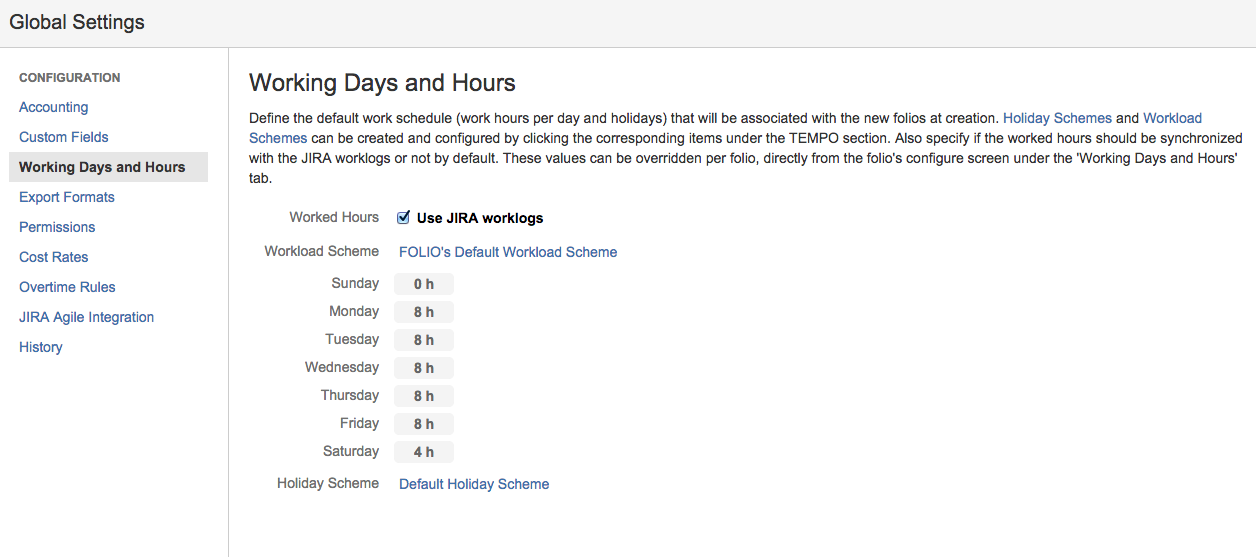
|
Worked hours |
If the Use JIRA Worklogs option is selected, then the actual costs related to staff members will be automatically calculated based on hours logged on the Folio's issues. If not selected, Tempo Budgets evaluates the number of worked hours of a staff member based on his or her Availability percentage. |
|---|---|
|
Workload Scheme |
Defines the weekly work schedule: the normal number of work hours per weekday. Workload schemes are defined by JIRA administrators under the Tempo / Workload Schemes section of JIRA's Add-ons page. Click the Workload Scheme's name to view or modify it. |
|
Holiday Scheme |
Defines the default non-working days for the Folios. Holiday Schemes are defined by JIRA administrators under the Tempo / Holiday Schemes section of JIRA's Add-ons page. Click the Holiday Scheme's name to view or modify it. |
Export Formats
The Export Formats tab lets you specify formats for dates and numbers when you export costs, revenues and staff members in CSV.
This configuration can be overridden at the Folio level.

|
Date Format |
Formats for date
Must follow the standard Java guidelines |
|---|---|
|
Grouping Separator |
Grouping separator for numbers
|
|
Decimal Separator |
Decimal separator for numbers
|
Custom Fields
This section allows you to define Custom fields and a default prioritization for Folios. Custom Fields allow you to enter extra information in your Folios and have it displayed in their Overview and Steering Committee Report, as well as new columns in the Manage Portfolios screen. Values of these custom fields are specified in each Folio's configuration, under the General Information tab. Furthermore in this section, you can select one existing Folio custom field to be used for ranking (prioritizing) Folios. The value of the ranking field will then be used to determine the sorting order of Folios in the Manage Portfolios screen and as the default sort order for Folios in the Portfolio Overviews and Steering Committee Report.
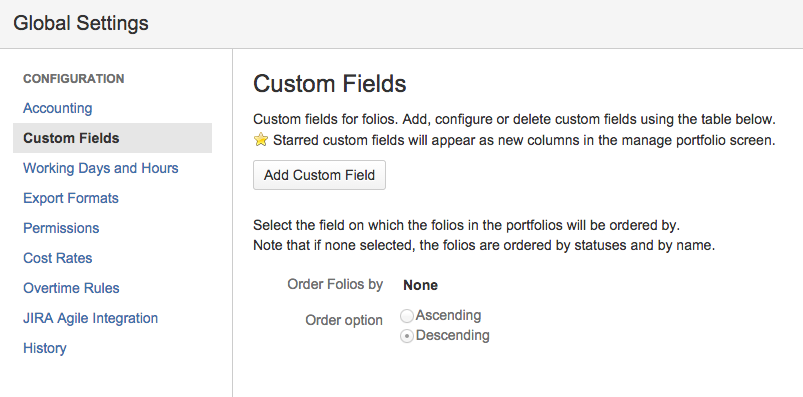
Managing Custom Fields
The Folio Custom Fields tab in Tempo Budgets's Global Configuration screen shows the list of all Custom Fields already defined for your Folios. They are sorted alphabetically and each entry in the list displays the following:
-
A number between parentheses indicating the number of Folios that have a value specified for that field. Nothing is displayed if no Folio has a value for that field.
-
The name of the Custom Field
-
The custom field type
-
The custom field options (in the case of a Select List)
-
If the field is required or not
-
If the field is starred or not
Various types of custom field are available.
-
Text Field (single line) - A basic single line text box custom field to allow simple text input.
-
Select List (single choice) - A single select list with a configurable list of options.
-
Number Field - A custom field that stores and validates a numeric (floating point) value.
-
Amount Field - A custom field that stores, validates and formats an amount value. The Folio's currency is implied for formatting.
-
Date Picker - A custom field that stores dates and uses a date picker to view them
-
User Picker (single user) - Choose a user from the user base via a popup picker window.
Making the field Required will force users to enter a value when adding or updating a folio.
Starred Custom Fields
( 

Specifying Folio Ranking
One of the existing Folio custom fields can be selected to be used for ranking (prioritizing) Folios. The value of the ranking field will then be used to determine the sorting order of Folios in the Manage Portfolios screen and as the default sort order for Folios in the Portfolio Overviews and Steering Committee Report.
To select a Custom Field to be used for ranking, click the value (in bold) of the Order by setting to make it editable. Start typing the name of the Custom Field to use and then select it in the suggestions appearing below the field. Selecting None means the default sort order will be used for Folios. When an Order by value other than None is selected, the Order options become available. Select Ascending to have Folios sorted by their ascending ranking field value, Descending for the opposite.
The sorting of Folios based on the selected Custom Field is determined as follows:
-
Values starting with numbers are considered smaller than values starting with letters
-
ex: 123 < ABC
-
-
Values starting with numbers are compared by their leading numeric part first, then alphabetically using the remaining part.
-
ex: 1 < 02A < 02B < 11
-
-
Values not starting with numbers are sorted alphabetically, case-insensitively.
-
ex: AA < aB < cc
-
Note that Folio sorting can be overridden per Portfolio, through the Manage Portfolios screen.
Jira Agile Integration
To be able to create folios associated with a Scrum or a Kanban board, Tempo Budgets needs to be connected with JIRA Agile. By default, Tempo Budgets automatically detects and attempts to connect with JIRA Agile when starting up. If for any reason Tempo Budgets fails to connect with JIRA Agile, you can manually trigger the connection by clicking the Connect now button.
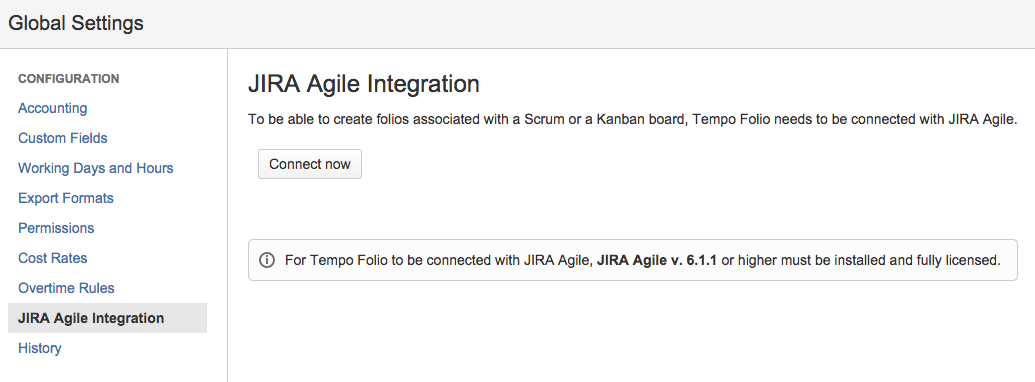
Permissions
Global permission settings allow you to:
-
Control visibility and access to Tempo Budgets
-
Define Tempo Budgets Super Administrators
-
Define Cost Rates Managers
-
Control visibility of portfolios
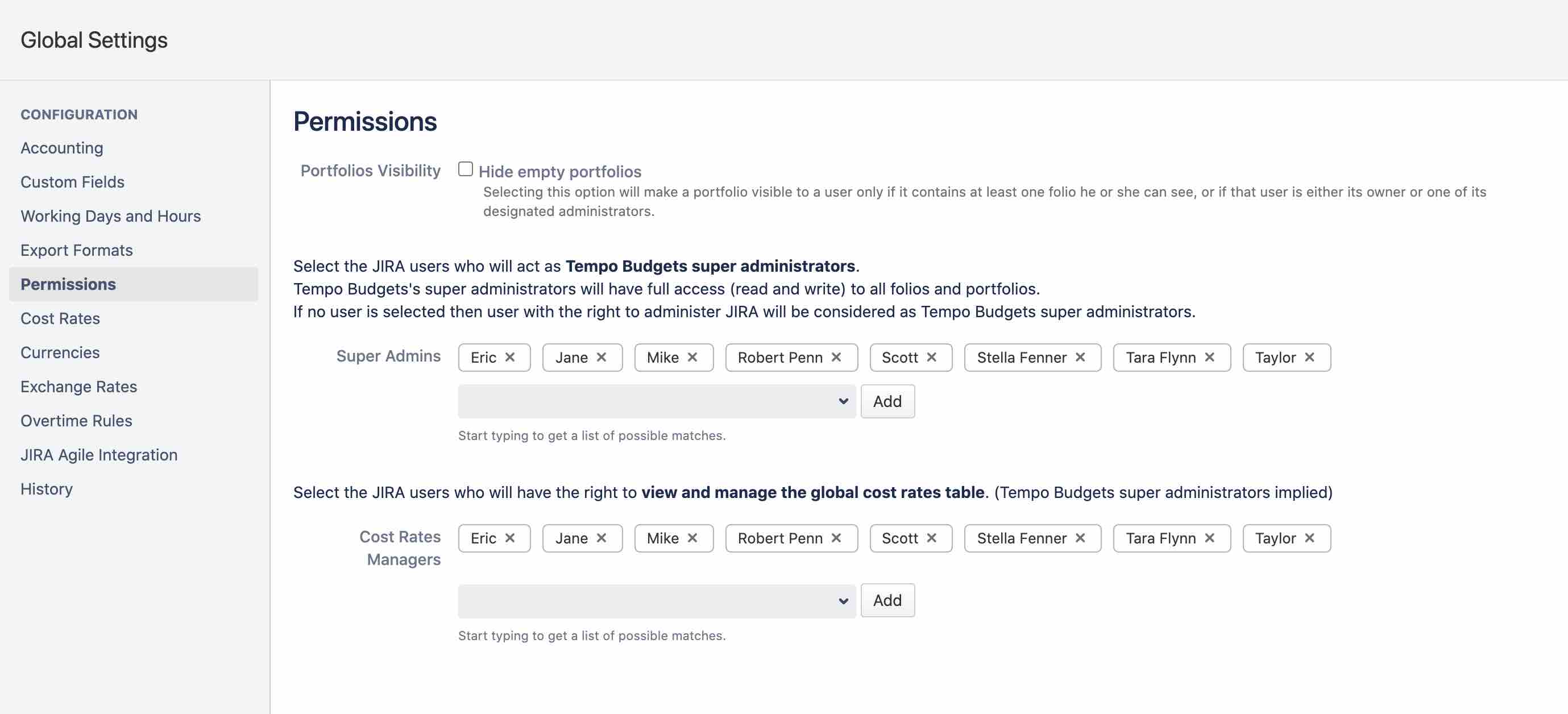
Portfolios visibility
Portfolios that are visible to users in the Manage Portfolios screen depends whether this setting is checked or not.
Hide empty portfolios is unchecked
All portfolios will be visible to all users, or
Hide empty portfolios is checked
Users can only see portfolios :
-
that they own (which by default includes those that they have created).
-
for which they are designated as an Administrator.
-
that are associated with at least one folio that they can browse.
Tempo Budgets Access Permission
You can grant or deny access to Tempo Budgets to specific groups in your organization, or to external Jira users with permission to view your Jira issues. By default all Budgets users are considered as members of Jira-software-users and can access Tempo Budgets from the Tempo menu. You may choose to deny grant or deny access to Budgets by modifying the Jira groups that will have access to Tempo Budgets.
You can access the Tempo Budgets Access Permission by:
-
Going to Jira Administration > System screen, Under Security > Global Settings.
Users who don't have access to Tempo Budgets won't see anything regarding Folios and Portfolios under the Tempo menu.
Important
Note that because the Budgets' Super Administrator role is assigned to an individual and not a group, the Jira Administrator will need to grant an existing Super Administrator access to Budgets when they migrate to a new version.
Tempo Budgets Super Administrators
You can specify one or more users to act as Tempo Budgets super administrators. Super administrators have full access in read and write mode on all folios and portfolios, including cost rates. They are the only ones who can edit Folio's global settings (except Global Cost Rates which can be edited by Cost Rates Managers). If no user is specified, Jira administrators are super admins by default. Note that you can possibly lose edit rights on global settings (including permissions) by removing yourself from the super admin users.
Cost Rates Managers
You can specify one or more users who can view and modify the global User cost rates table. They are the only users who can view cost rates of Folio's staff members that use global user rates and who can publish Folio-local user rates to the central User cost rates table. Tempo Budgets Super Administrators are automatically Cost Rates Managers.
History
Tempo Budgets Super admins can consult the change history of the global configuration. When logged in as a Tempo Budgets super administrator, go to the Add-ons page and click the History item under the Tempo Budgets menu section to view the audit trail.

Related pages:
